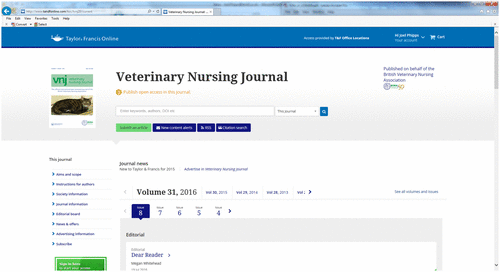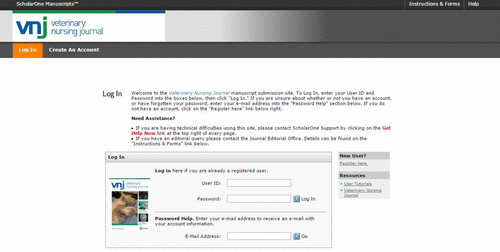Abstract
The thought of writing an article for a journal can be a daunting one, especially if this is the first time that you have considered writing one. Thinking about the type of article and intended audience and planning the article thoroughly will provide a sound basis to begin writing and conducting a thorough literature review whilst being critical of the literature utilised will ensure a current and evidence-based approach. It is also essential to understand the submission and review process, formatting requirements, deadlines and checklist for submission for the journal to ensure that your article doesn’t stall at the last hurdle.
Many people struggle with the concept of writing an article and when asked to contribute to a journal by editors will often reply with the words “I wouldn’t know where to begin”. The benefits of article submission are numerous. Firstly, it counts towards your continuing professional development (CPD) record for the Royal College of Veterinary Surgeons (RCVS). Secondly, you will receive remuneration from many journals (including the VNJ) once your article has gone to print. Thirdly, writing an academic submission for a journal is an achievement and should be proudly included on your curriculum vitae. Fourthly, as a profession of reflective practitioners, the best way to disseminate information to other members of the profession is to write about it.
The truth of it is that anyone can write an article if they can find something that they truly believe in to begin writing about.
So where should you begin? There may be a particular area of Veterinary Nursing that really interests you and you would enjoy researching, or you may have nursed an unusual case that you would like to share. You might be an RVN who has recently undertaken an advanced diploma or BSc and be willing to share a literature review or clinical research project that you undertook as part of your studies. Alternatively, you may be a student Veterinary Nurse willing to share your experiences or an academic submission that you are particularly proud of. The most essential point regarding a topic is that you clearly understand the area in which you will be basing your article.
Secondly, you need to consider the intended audience for the piece. Do you want to stretch and challenge nurses who are undertaking additional professional or academic qualifications, or are you aiming to identify with and educate our student population? Or are you aiming for the biggest readership of all, the RVN in practice who reads the journal to establish new ideas and reflect on practice procedures and protocols?
Once you have your idea or subject area and your key audience then it is important to understand which type of article that you will be submitting. The VNJ currently accepts two broad types of article and you will be asked at the electronic submission point to select which of these best fits your submission. The feature articles often focus on a particular case or treatment, but may also focus on career pathways, volunteering, topical issues and discussion pieces. Clinical articles may include literature reviews, primary clinical research, clinical audits and more in-depth, evidence-based case studies. It should be noted at this point that feature articles tend to be shorter with a maximum word count suggested of 1500, whilst clinical articles should expect to be 2000 words.
Clinical articles should be fully evidence-based utilising current research and using APA referencing. Full details of the guidelines for authors can be found on the Taylor and Francis website (see Figure ) at: www.tandfonline.com/action/authorSubmission?journalCode=tvnj20&page=instructions#.V5Ukl_krLIU. Once the type of article and a rough title are confirmed then please contact the Editor-in-Chief or the Executive Editor of the VNJ to let them know what you intend to write and when you intend to submit. These deadlines are important for the smooth running of the journal and all articles must be completed to go into production three months ahead of final print.
Figure 1. The guidelines for authors and other useful information can be found on the VNJ section of the Taylor and Francis website

The next step is to begin to write a plan for your article, what you intend to include and how this will be structured into paragraphs that flow together throughout the piece. Planning in this way will also help to ensure that you apportion equal weighting to the key points and considerations that need to be focused on, rather than writing aimlessly and realising sometime later that you have written 1000 words on just the first element and that it is not terribly succinct.
Ensure that you have a clear introduction to the piece that sets the scene for the bulk of the discussion. Clinical articles should be written with a technical and academic approach and are almost always in the third person and past tense. Feature articles may have a more personable, first-person approach in some instances, but should still be written from a professional viewpoint. Some top tips for writing your article can be found in Table .
Table 1. Top tips for writing your VNJ article
Table 2. Submission checklist for the VNJ
For many articles the next step is to begin to search for relevant literature and where you do this will depend on what journals you personally have access to. It is advisable to choose a few key words to help you plan your search before you begin to use the academic search engines such as PubMed, Google Scholar, Scopus, OVID medicine and the like. You can of course search individual journal databases for relevant back issues and VNJ back issues can be accessed through the member area on the BVNA website. Combining or exempting associated keywords using “AND”, “OR” and “NOT” functions in these search tools will help to maximise your chances of success and many will allow you to set the timeline for your results to ensure that literature utilised is current.
For a clinical research piece the introduction will traditionally introduce the literature, rationale for the study and what is currently known about the independent and dependent variables before outlining the research aims and hypotheses. For clinical research the method will then follow the introduction. This methods section should introduce subheadings such as: participants (to include any exclusions, actual versus proposed sample size, nature of participant recruitment, i.e. was it opportunistic), materials (what equipment, drugs and consumables were used), method including ethical review process (the method should outline what was done in a way that another researcher could replicate the study exactly) and data analysis including the statistical tests used in the study. Do not critique your method at this point, as that should be reserved for your discussion.
The results section comes next and should be a concise summary of the results of the study, usually accompanied by graphical display of some of the data. The results will generally outline the demographic, descriptive and inferential statistics and indicate the significance of the results.
The discussion sums up the findings by evaluating the results, the strengths and weaknesses of the study, critiques the methods and draws back on the literature in the introduction for comparison and also to justify the inferences made regarding the results. Finally, the last section of the discussion concludes the context of the findings alongside recommendation for future research.
Literature review articles may look at the evidence for using a piece of equipment (such as a Bair Hugger™ for patient rewarming during anaesthesia) or have a wider scope, such as drawing together current thinking on infection control in veterinary operating theatres. The introduction again sets the scene for this type of piece and the main body of the discussion focuses on a critical analysis of the available literature. When writing a literature review you need to critically review the literature that you have found in your searches by assessing the validity of their method, analysis and conclusions. This initially involves looking at how current the research is, whether it is generalisable to the wider population (for example, a study in a particular breed of dog looking at drug metabolism may not be the same in another breed of dog), the sample size utilised, the relevance to the general practitioner, whether the results were significant and what statistical tests were performed, what was concluded from the results and whether fair and reasonable inferences have been made. For this type of article the structure of the piece is key to ensuring that the flow of the written expression holds reader interest whilst giving a clear overview of the current stance according to the evidence base.
Regardless of article type, you should not embed any pictures of tables into the Word document, but instead upload these as separate files when it comes to submitting the article. Alongside the separation of files, you should also indicate where in the text that these should be placed: . All articles should be accompanied by five to six high-resolution pictures. A 100-word abstract should also be included for every article. This is not simply a repeat of the introduction, but should summarise your article and for clinical research should give the reader a synopsis of your project including the results.
Finally, before you upload your article to the submission point on the website, ensure that you have the required number of pictures and that they are the dictated resolution necessary for the journal; ensure that any figures and tables are available as separate uploads and not embedded in the article; include your name, post nominals, affiliation and email address (see Table for submission checklist). A note on proof-reading seems essential here and it is always best to put aside your work for at least 48 hours prior to assessing it for mistakes otherwise the cognitive processes in the brain “trick” you into reading what you want to read rather than any mistakes on the page. It would be prudent to ask a colleague to read it for you to ensure that you have pitched it at the right level, fully referenced (if necessary) and that the piece flows together well.
All articles to the Veterinary Nursing Journal should be submitted via the Taylor and Francis online portal (see Figure ). If you have not submitted to the journal before then you will first need to create an account. Following submission, your article, pictures, tables and figures will be checked as part of the admin process and once the piece has passed these checks it is forwarded to the editor centre. From here two reviewers are assigned to your submission and review your work and provide comments and a recommendation on publication to the editor. The VNJ operates a double-blind peer-review system, which means that the reviewers do not know who has written the article and you will not know who has reviewed your article. This is best practice in reviewing and it should put you at ease to know that you cannot be identified at this stage. The initial review process can take up to a month and then your manuscript will be electronically accepted for publication, accepted with revisions, or rejected. The most common of these is the accepted with revisions decision – this does not mean that your original submission was not good enough, but rather that comments have been provided in a constructive manner by the reviewers to help make your article the very best it can be. It can be a little daunting to receive reviewer’s comments, but please remember that it is not personal and do not give up and decide not to continue with publication. Every peer-reviewed journal article, including all the empirical research, that you have read during your literature review has been through this process and some may have even been rejected from another journal initially. If you have any concerns regarding the review process or disagree with reviewer comments, then please do not hesitate to contact the Editor-in-Chief or Executive Editor.
Figure 2. All submissions for the VNJ are electronic via the author account portal. This can be found under submission on the website

The whole peer-review process from submission to final approval can take a number of months, so please bear in mind that when you add this to the production process it will often take approximately six months for your article to appear in the journal. We will often earmark articles for specific feature editions of the journal and if your article is intended for a specific edition then it is imperative that you work alongside the editors and reviewers to meet the deadlines.
The final word really is to just ask “what are you waiting for?” and recommend that if you would like further advice or information regarding article writing then please contact the Editor-in-Chief or Executive Editor of the Veterinary Nursing Journal.
Additional information
Notes on contributors

Sam McMillan
Sam is course director and lecturer on the BSc (Hons) in Veterinary Nursing for the College of West Anglia and Anglia Ruskin University and also the current Editor-in-Chief of the VNJ for BVNA. Sam’s main interests include anaesthesia and analgesia, patient safety and theatre biosecurity. Email: [email protected]
